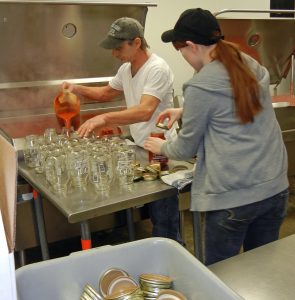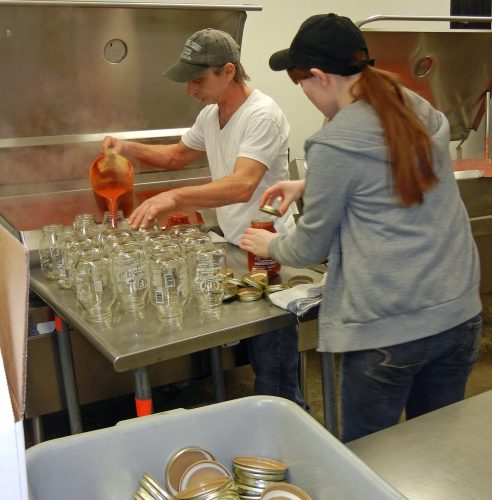
Tony Figaretti, Jr., president of Figaretti Manufacturing, Inc., and Brittany Berisford bottle sauce at his Peters Run Road plant. Supply chain snarls have made it difficult to consistently get key elements ranging from dried basil to jar lids. (Photo by Nora Edinger)
WHEELING — A perfect storm of distribution difficulties is one thing when it shows up as a newspaper story about a faraway factory, or even as an empty shelf at a neighborhood grocery store.
But, when such troubles mess with beloved home-turf products like Figaretti’s Spaghetti Sauce or the Fiestaware plates on which it might be served, it gets personal.
“You have it (supply chain problems) with ingredients of the sauce,” said Tony Figaretti, Jr., president of Figaretti Manufacturing Inc., which bottles at a small plant on Peters Run Road. “(And, it’s) the lids, the jars, the boxes. There’s a question mark behind it – when will it arrive, if it’s going to arrive at all?”
One recent supply truck didn’t include dried basil, a necessary sauce ingredient, for example. “We couldn’t produce that day,” he said, noting a normal day’s production is about 1,200 32-ounce jars.
The company has avoided the staffing shortage that is plaguing many manufacturers and other businesses and industries.
Figaretti explained that three of the five employees at the five-generation enterprise are family. It’s the supply chain and shipping parts of the snarl that loom large.
Supply chain-wise, if it’s not basil, Figaretti said it might be the slow arrival of tomato paste from California farms or a lack of lids needed to bottle up the sauce. The tin discs that are stamped into lid shape at a Berlin, Ohio company must travel from China and, then, across the U.S – a sea-land path marked with notorious delays since COVID first disrupted the supply chain in 2020.
And, Figaretti said, even when the 400 to 800 cases of sauce the company produces each week are good to go, they sometimes wind up sitting instead of heading to Kroger distribution points in Indiana and Tennessee. (He noted Kroger purchases about 90% of the local product.)
That can be because of a lack of drivers, Figaretti said. Or, the transport cost — which varies daily — might be so high he opts to wait a day or two to see if it will go down.
Such vagaries, of which Figaretti said he sees no end in sight, are literally adding up. His sauce price is currently running 33% higher than it was before the supply snarl.
“I think people understand,” he said of customers trying to fathom the complicated issue when they’d rather be cooking up pasta dishes. “They’re just awfully upset about the price increases.”
SPINNING PLATES
Just up the river, Fiesta Tableware Co. is facing similar problems, just on a larger scale, according to Matt Wicks, chief operating officer.
Wicks said the 151-year-old plant in Newell (formerly named the Homer Loughlin China Co.) has come precariously close to shutting down production more than once in recent months due to lack of supplies.
“It affects us almost every day,” Wicks said. “Something else comes up that you wouldn’t have expected to have a delay on and it leads to a quick shuffle.”
In the fall – when the Wall Street Journal featured the plant in a story about supply chain and a holiday surge in demand for Fiesta’s colorful tableware – there was a shortage of the pigments needed for the company’s signature glazes. Wicks has since checked that problem off his list as alternative sources were found, but other production holes showed up just as quickly.
It’s now flint – a critical component of the pottery — and machine parts, he said.
“It’s not that there’s a shortage of flint in the United States,” Wicks explained of his supplier having trouble getting parts to keep his own operation running smoothly. “It all goes downstream.”
Or, by jetstream in the case of some machine parts.
Wicks said he is often told – by still other companies in the same struggle — that a part will arrive in two months. That date arrives, and they then say it’s going to be another two months.
If the delay is such that it’s going to shut down the production line – a big issue when nearly 500 workers are involved – Wicks has taken to airfreighting parts in from wherever they can be found. It’s an expensive option that, combined with other cost increases, raises product prices.
That said, Wicks called the conundrum more aggravational than operational to date. The company launched a new color – peony (blush pink) – this month and is currently working ahead of schedule, storing up pottery of all colors during the slower post-holiday season lest it get caught short in coming months. With 37 acres under roof, Wicks said there is space to do that.
Wicks hopes there is also a timing factor in play.
“Since COVID-19 began hitting, we’ve seen a great resurgence of our brand, which is phenomenal,” he said, “not only because it’s U.S.-made but because it has a feeling of comfort.”
Noting that Fiestaware began in the Great Depression, when families circled up around brightened dinner tables during that troubled time, he’s hoping this round of adversity will continue to similarly inspire today’s world-weary shoppers.
“The biggest thing to learn from this,” he said, “is to continue to support the people in your backyard, those American manufacturers.”


